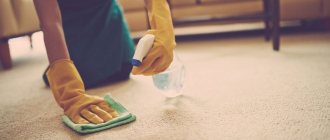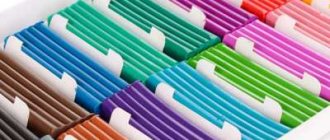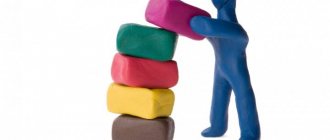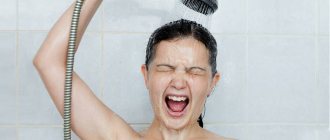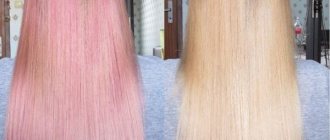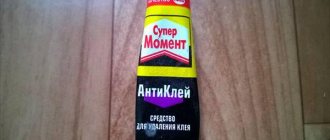Our children love to sculpt, while adults encourage this creative activity with mixed feelings. After all, then you inevitably have to clean up the consequences of childhood inspiration. Plasticine goes everywhere, even if you take care of everything: the table and the clothes. It is impossible to list everything that a child can touch with dirty hands or where a sticky piece can fly into.
But it's not so bad if you know how to clean plasticine from a carpet. And. how to wash plasticine from toys, hair, hands and other things.
Let's answer the questions in order. But first, let us remember that the modeling mass, which we call plasticine, consists of mineral waxes, polymers, dyes, rubber and paraffin. Each of the components can be influenced in a certain way.
We discussed the freezing method in the article How to clean plasticine from clothes. It is also suitable for small items such as soft toys, pillows or bags. However, you cannot place a carpet, rug or a child’s hair stained with sticky mass in the refrigerator. Then how to remove plasticine, how to get rid of plasticine stains?
How to remove plasticine from a child's hair
Do not rush to cut off strands of matted hair. Mothers of creative children know very well how to remove plasticine from hair, even very long and thick hair. The most difficult thing will be to persuade a small child to be patient.
It may be a little painful and you will have to sit or stand in an uncomfortable position, but it will be worth it. The sticky mess can be cleaned off without a trace and even with benefit for the hair.
You can first try to remove the plasticine from your hair with a piece of linen or flannel, carefully scraping off the sticky mass.
Attention: Make cleansing movements according to the hair growth, holding the strand from above with your hand. This will cause less pain. Having your hair pulled is not very pleasant even for an adult.
Flannel is dense and fleecy enough to absorb most of the melted substance. If the child does not want to endure it and cries, quit this activity and use another, more gentle and effective remedy.
We take any vegetable oil available in the house. Castor, almond or peach oils are best, but kitchen herbs will remove plasticine from hair just as well. It's just a little more difficult to wash off. You can use any cosmetic oil.
Information
Now the only important thing for us is the ability of vegetable oils to soften plasticine.
Then you will have to take napkins or paper towels and remove the softened mass with movements from top to bottom so as not to injure the hair follicles and not cause pain to the child. And your hair will be less tangled. Afterwards, all that remains is to rinse your hair with shampoo several times with tolerably hot water. Usually these measures are enough to remove plasticine from a child’s hair. Consider that at the same time you also made a nourishing mask for your hair.
Another way to clean plasticine from a child’s long hair is in the video. An excellent way, by the way, if you don’t have time to wash your hair (it’s time to get ready for kindergarten or school) and it will also take a long time to dry your hair. In this case, oil is clearly inferior to hair conditioner.
What are the best methods to avoid removing plasticine?
It is not recommended to use aggressive substances - those that can disrupt the hair structure and make it weaker. This will also negatively affect the condition of the scalp. The cover will become inflamed, covered with scales, and constantly itch.
Expert opinion
Natalia
Housewife
Do not use solvents, stain removers, or washing powders. The recommendation applies to all products with a deliberately aggressive formula. Even toothpaste can negatively affect the condition of your hair and scalp. Therefore, when choosing one method or another, you need to take into account security measures.
How to clean carpet from plasticine
This will be a little more difficult. But again we proceed from the properties of the modeling mass to harden when exposed to cold and melt when heated.
Advice
There is no need to try to clean plasticine from a carpet or rug with brushes and scrapers. The area of contamination will increase and it will be extremely difficult to remove everything without a trace. You shouldn't use a vacuum cleaner either. Even small particles scraped off inside the garbage disposal will soften and clog the filter. If you do have to vacuum, immediately empty the garbage bag.
Mechanical removal
Small parts can also be removed manually.
Under no circumstances should you use a comb - you will only harm the baby.
On one side you need to take a strand of hair to which the plasticine has stuck, and on the other hand, carefully break the pieces. This works well once the material dries and crumbles. It is important not to pull the child’s thread, but to hold it as tightly as possible in front of the place where the dirt has dried.
Tip: do not remove plasticine mechanically if it sticks to the hair right at the root. Any movement can cause severe pain, in which case you should use the home methods described below.
Cold
You can’t stuff a bulky carpet into the refrigerator; you’ll have to figure out how to bring the cold to the place of contamination. The best option is dry ice. If you can get it, consider half the job done.
If the modeling material did not leave greasy paint marks, then removing plasticine from the carpet will end with your victory.
However, ice from your home refrigerator is also quite effective. Don't forget to place the ice cubes in a plastic bag. Once hardened, the plasticine mass can be easily scraped off. It is important to remove all the particles without leaving a trace before they become soft and stick again.
Flannel fabric
You can also use a cotton, wool or wool blend cloth to remove dried plasticine from your hair.
Wrap a small piece of cloth around the debris and try to remove it from root to tip. The hair should be held tightly at the base so as not to injure the baby. With a firm but gentle movement, you can pull out a bunch of plasticine from the hair, leaving almost no traces. After cleansing your hair, wash your hair with baby shampoo or toilet soap, sprinkling your hair well with it.
Warmth
Using a hairdryer, warm the plasticine stain through a napkin, gently pressing the napkin with your hand, making wetting movements. We change napkins. We melt the mixture until the greasy stain no longer appears.
It is more convenient to use a hairdryer if the floor covering or rug is synthetic and it is scary to touch it with a hot iron.
An iron will do a better job of softening than a hairdryer. But we don’t iron it, but press the iron against a napkin or paper towel placed at the site of contamination until marks appear on the absorbent material. We change the napkins so as not to create new stains.
Features of removing plasticine from a child’s hair
There is a large selection of plasticine for children's creativity, which differs in its paraffin and fat content. The more of these substances it contains, the more plastic the mass and the more convenient it is to work with, but such material for children’s creativity is more difficult to remove from a child’s hair. With such a plasticine mass it is necessary to work with freezing. The more the lump freezes, the easier it is to remove it mechanically, and shampoo and conditioner will help do the rest. The use of balm is recommended for such cleaning, as it changes the properties of the hair. They become soft and pliable to comb.
Removing greasy stains
All that remains is to remove the residual greasy stains. All store-bought products designed to remove stains from carpet or upholstered furniture are suitable for this purpose. It is better to use them, since it is impossible to rinse all the soap solutions from such bulky things.
If for a carpet the advice to apply a soap solution and then wash it off with water can still be useful (due to its hairiness, you may not notice the boundary between the reduced stain and the rest of it), then this method does not work for rugs and floor coverings.
But household chemicals, which can be picked up at any hardware store, come to the rescue. You can also use auto chemicals to clean the interior.
Preventing plasticine from getting into baby's hair
Before starting a creative activity, the child’s hair should be protected as much as possible. First of all, for girls, pin up their long locks, preventing the plasticine from penetrating into the long locks. It is better to wear a headdress on your head: for girls - a headscarf, for boys - a light cap or bandana.
When creating works of art, provide the child with a damp cloth or napkin with which he can wipe his hands as needed. This will teach the baby to be clean and get rid of dirt.
When choosing a material for children's creativity, you need to take into account the paraffin and fat content. Oily plasticine will be more difficult to deal with if it gets into your hair. Although plasticine with a high content of paraffin and fat is more elastic and easy to work with, a small child should buy simpler plasticine.
The baby should be given instructions, explaining the consequences of plasticine getting into the hair.
You shouldn’t limit your child’s creative activities just because he will get his clothes dirty and get dirty himself. You just need to teach him to be neat, choose appropriate clothes and a hat. If plasticine gets into your hair during classes, then you just need to use the tips given above.
Alcohol solutions
To remove plasticine from carpets and rugs, you can use white spirit or any product containing alcohol. Vodka is also great. It will perfectly break down all greasy marks and at the same time dissolve the colored stain. Everything disappears practically without a trace.
Ammonia will clean the carpet perfectly, but its smell will hang around the apartment for a long time, poisoning your life. But if you can leave the house and leave the windows open for a long time, then ammonia is one of the best means of cleaning greasy stains from a fleecy or fabric surface.
In this case, you need to dilute it in a glass of water by adding 10 drops. This is enough to remove any greasy stains. Wet a cotton swab with the solution and blot, moving towards the center of the stain until it disappears completely.
Attention
If you use ammonia to remove plasticine stains from clothes, then mixed, dyed and synthetic fabrics cannot be treated with it. Only cotton and preferably of a dense texture.
Sunflower oil
Under the influence of temperature, the oil very quickly softens the plasticine.
Using a watercolor brush, generously moisten the dried lump with warm margarine, butter or sunflower oil. After a few seconds, the clay will be soft enough to be removed with a dry, clean cloth.
Attention! When using vegetable oil, the head must be cleansed with extreme caution, otherwise the hair will remain greasy and have an unpleasant odor.
Vegetable oil will help remove plasticine from wallpaper and dried paint from clothes.
Alcohol
Alcohol solutions are called “loyal solvents.” The liquid easily copes with plasticine, but does not cause damage to the surface being treated. First, the lump is liquefied, then you use your hands and remove the dirt mechanically. An alcohol compress was considered a good way to influence the mother. Here's what you need to do:
- soak a cotton pad with an alcohol-containing substance;
- apply cotton wool to the dried plasticine;
- hold for 10-15 minutes (ask the child not to move);
- Change compresses periodically, since alcohol tends to evaporate.
Having seen the softening, have you thought about how to get plasticine out of your hair? The bulk of the polymer is removed manually. When a small stain remains, take your child to the bathroom and wash his hair with shampoo. If necessary, the procedure is repeated.
Methods for cleaning clothes from plasticine
The following tools will help you remove greasy stains:
- laundry soap;
- washing powder;
- vegetable oil;
- ammonia;
- isopropanol;
- dishwashing liquid.
In addition, you cannot do without an iron, hair dryer, paper napkins, and stain removers.
Methods for removing greasy marks from fabric:
To remove plasticine from clothes, follow these steps:
- Place the item in a bag and put it in the freezer.
- After 30 minutes, take out the item, break the plasticine into pieces, and carefully scrape it off with the edge of a knife so as not to damage the fabric.
- If there is a greasy stain left on the surface, wash it.
Laundry soap will help remove dirt from light, plain fabric:
- Check the label for information about the appropriate washing temperature.
- Mix soap shavings and water at the required temperature; the solution should be concentrated.
- Place the item in the solution for 20 minutes.
- Apply soap to the dirty area and scrub.
- Use warm water to rinse.
If the grease stain persists, sprinkle baking soda on it and scrub.
Ammonia is used to process natural materials:
- Mix 200 ml of water with 10 drops of ammonia.
- Dip a cotton pad and rub the stain until it disappears.
- Rinse and wash the item.
Ammonia is replaced with undiluted isopropanol.
To remove contamination, use vegetable oil:
- Use a napkin dipped in oil to wipe the stuck lump until it comes off.
- Concentrated dish gel is poured onto the stain and the item is left for 20 minutes.
- Then the product is washed in a machine, but the water temperature should be maximum (for this type of fabric).
Stain removers will help remove traces of plasticine from jeans:
- Prepare the concentrate according to the instructions.
- Soak the contaminated area.
- Wash as directed in the manual.
To remove colored cake from pants, follow these steps:
- Turn the product inside out and place it on the table.
- Cover the dirty area with newspapers (2-3 layers) on top and bottom.
- Iron the item with a hot iron so that the fat is absorbed into the paper.
- Then remove the dirty newspapers and add clean ones. Repeat the procedure until greasy spots no longer appear on the paper.
Make sure that the area of the newspaper is larger than the area of the iron.

